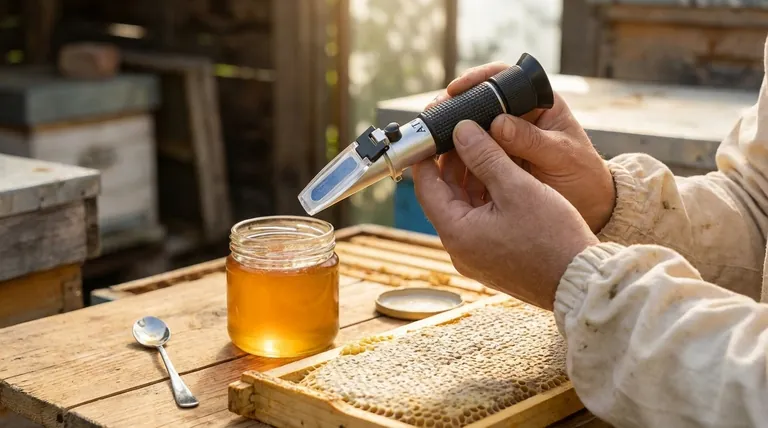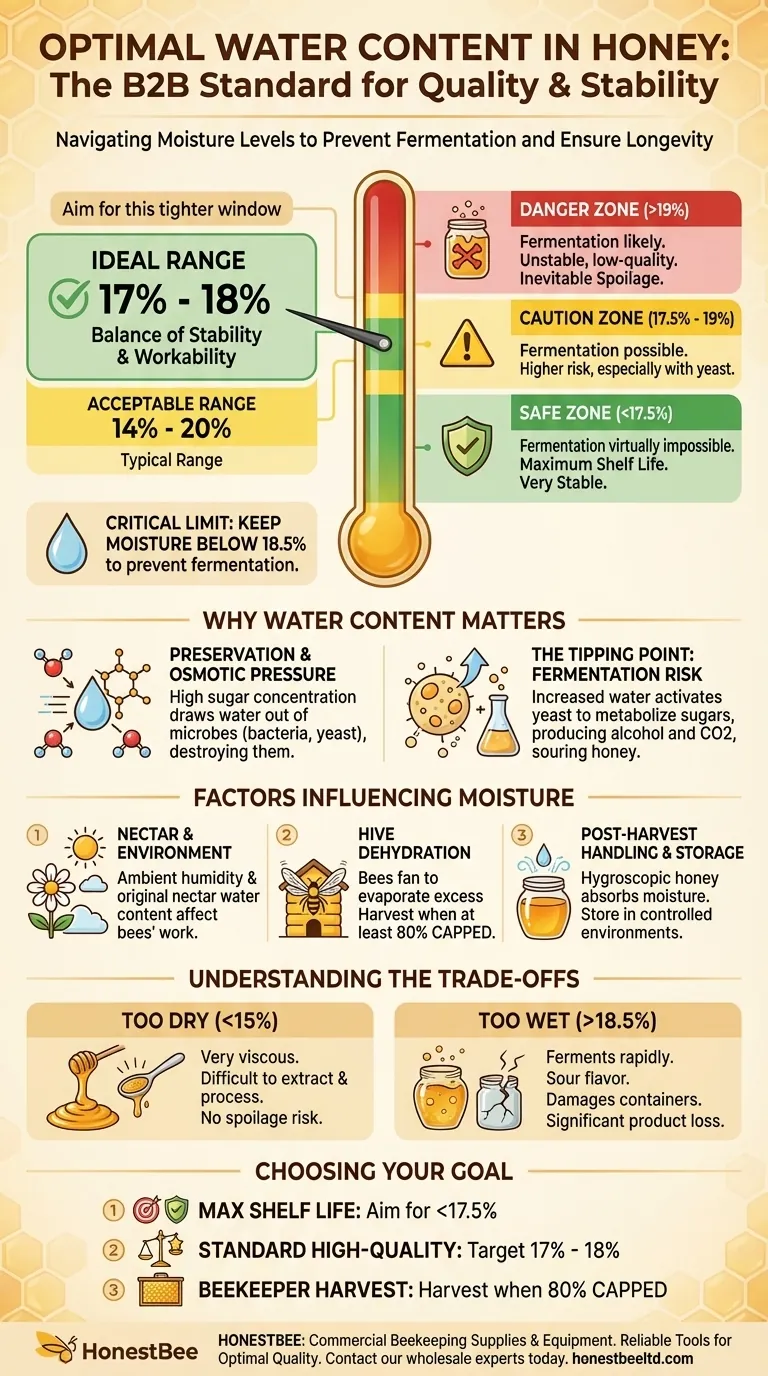For optimal quality and long-term stability, the ideal water content in honey is between 17% and 18%. While the acceptable range for typical honey is between 14% and 20%, aiming for this tighter window is the professional standard. Keeping moisture below 18.5% is critical to prevent the fermentation that spoils honey and degrades its value.
The core challenge in honey production is managing its water content. This single factor dictates honey's shelf life, quality, and resistance to spoilage. Controlling moisture is not just about following a number; it's about preserving the natural integrity of the honey.

Why Water Content is the Key to Honey Quality
Understanding the role of water is fundamental to understanding honey itself. The moisture level is the primary variable that determines whether honey will last for months or millennia.
The Role of Water in Preservation
Honey is a supersaturated sugar solution, and its low water content creates high osmotic pressure. This environment is incredibly hostile to microbes like bacteria and yeast, as it effectively draws the water out of their cells, destroying them.
This low moisture level is honey's primary natural defense mechanism.
The Tipping Point: Fermentation Risk
When the water content rises, the osmotic pressure drops, and dormant, naturally occurring yeasts can become active and begin to metabolize the sugars. This process is called fermentation, which produces alcohol and carbon dioxide, souring the honey and ruining its quality.
The risk of fermentation increases dramatically at specific thresholds:
- The Safe Zone (Below 17.5%): Fermentation is virtually impossible. Honey is exceptionally stable and will not spoil.
- The Caution Zone (17.5% to 19%): Fermentation is possible, but typically requires a high concentration of yeast to begin. This is a higher-risk range.
- The Danger Zone (Above 19%): Fermentation is likely, and honey with over 20% water content will inevitably ferment rapidly. This honey is considered low-quality and unstable.
Factors That Determine Honey's Moisture Levels
A honey's final water content is not an accident. It is influenced by the environment, the bees' diligence, and the beekeeper's practices.
Nectar and Environment
The process begins with the nectar's original water content and the ambient humidity. In humid climates, bees must work significantly harder to dehydrate the nectar to the proper level.
Honey Maturity in the Hive
Bees actively manage the dehydration process. They pass nectar from bee to bee and fan their wings at the entrance of the hive to create airflow, which evaporates excess water.
When the honey reaches the optimal moisture level (typically below 18.5%), the bees cap the honeycomb cell with a layer of clean, white wax. This capped honey is the signal that it is "ripe" and ready for harvest.
Post-Harvest Handling and Storage
Honey is hygroscopic, meaning it can absorb moisture from the air. Storing uncapped frames or extracted honey in a humid environment can cause the water content to rise, reintroducing the risk of fermentation.
Understanding the Trade-offs
While "drier is better" is a good general rule for stability, there are practical considerations at both ends of the spectrum.
The Downside of "Too Dry" Honey (Below 15%)
Extremely dry honey is very thick and viscous. This can make it difficult for beekeepers to extract from the comb and challenging to process and bottle. While it poses no risk of spoilage, it can present operational hurdles.
The Unacceptable Risk of "Too Wet" Honey (Above 18.5%)
The consequences of high moisture are severe. Fermented honey has a sour, "off" flavor, can damage storage containers as it expands, and is not suitable for sale or consumption. It represents a significant loss of product and effort.
The Nuance of Honey Type
Some specific types of honey can remain stable at slightly higher moisture levels due to their unique chemical composition. However, this is the exception, not the rule. For the vast majority of honey varieties, adhering to the standard guidelines is essential.
Making the Right Choice for Your Goal
Properly managing water content is the most critical step in ensuring high-quality honey. Your target should depend on your primary objective.
- If your primary focus is maximum shelf life and absolute stability: Aim for a water content of 17.5% or lower to eliminate any possibility of fermentation.
- If your primary focus is producing standard, high-quality honey: Target the industry-preferred range of 17% to 18% for an ideal balance of stability and workability.
- If you are a beekeeper deciding when to harvest: Use the bees' signal—harvest frames only after they are at least 80% capped, as this indicates the honey is ripe and at the proper moisture level.
Ultimately, controlling the water content is how you preserve the unique quality and value that the bees worked so hard to create.
Summary Table:
| Moisture Level | Risk Level | Key Characteristic |
|---|---|---|
| Below 17.5% | Safe Zone | Maximum shelf life; fermentation virtually impossible. |
| 17.5% - 19% | Caution Zone | Fermentation is possible; higher risk. |
| Above 19% | Danger Zone | Fermentation is likely; honey is unstable and low-quality. |
Ensure your honey meets the highest quality standards. Proper moisture control is essential for commercial success. HONESTBEE supplies commercial apiaries and distributors with the reliable beekeeping supplies and equipment needed to achieve optimal honey quality consistently. From refractometers to measure water content to efficient extraction systems, we support your operation at every step. Contact our wholesale experts today to discuss your needs and protect your product's value.
Visual Guide

Related Products
- Precision Honey Refractometer Instrument for Quality Assessment
- 0.5T Capacity Honey Dehumidifier Dryer with Vacuum Heating and Thickening Filtering Machine
- HONESTBEE 3-Frame Manual Acrylic Honey Extractor
- 6 Frame Manual Stainless Steel Honey Extractor Beekeeping Equipment
- 8-Frame Electric Self-Reversing Honey Extractor Spinner for Commercial Honey Extraction Equipment
People Also Ask
- What are the benefits of using a Pocket Digital Honey Refractometer? Achieve Precision & Speed in Honey Quality Control
- What are the features of the Standard Refractometer for honey moisture content? Essential Tools for Quality Control
- How does a honey refractometer work? Ensure Honey Quality & Harvest Readiness
- What are the key steps to using a honey refractometer? Ensure Honey Quality & Prevent Fermentation
- What is a honey refractometer and what is its purpose? Ensure Honey Quality and Prevent Spoilage



















